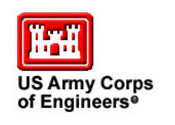
Army Corps of Engineers Releases Interbasin Study Plans
Chicago – The U.S. Army Corps of Engineers today released two documents for public review, the program management plan for the Great Lakes and Mississippi River Interbasin Study (GLMRIS), and the Other Pathways Preliminary Risk Characterization Report, a component of GLMRIS. The management plan outlines the scope of work and study process for GLMRIS. The Other Pathways Report focuses on identifying surface water pathways outside of the Chicago Area Waterway System (CAWS), such as streams, ditches, or floodways, that may allow aquatic nuisance species to cross the drainage divide between the Great Lakes and Mississippi River basins. The drainage divide separates surface water flow to the Great Lakes from surface water flow to the Ohio or Mississippi Rivers. The Other Pathways report does not address flow through the Chicago Area Waterways.
The Corps was directed in the Water Resources Development Act 2007 to conduct a feasibility study to determine the full range of options and technologies in order to reduce or prevent the risk of aquatic nuisance species transfer via aquatic pathways between the Great Lakes and Mississippi River basins.
The goal of the Other Pathways Preliminary Risk Characterization report, an important element of GLMRIS, was to characterize the relative likelihood of aquatic nuisance species transfer at each potential aquatic connection along the basins’ divide. The report provides a basis for prioritizing the connections according to relative risk and scoping a path forward at each potential connection.
“Developing the Other Pathways study was a collaborative effort involving more than 60 experts from a variety of federal, state, and local organizations. The GLMRIS effort will be an enormous and complex undertaking, so we look forward to continued collaboration with all interested governmental agencies and other parties as we transition completely into the execution phase of GLMRIS. We especially appreciate the Environmental Protection Agency’s support in providing critical funding for this effort,” said Maj. Gen. John W. Peabody, Commander, Great Lakes and Ohio River Division.
“Completing this study plan is another accomplishment in the aggressive strategy underway to protect our Great Lakes from Asian carp,” said John Goss, Asian Carp Director at the White House Council on Environmental Quality. “This plan was developed through strong Federal, state and local collaboration. Continued multi-agency support will be critical to help us proactively identify ways to block all identified pathways to the Great Lakes from Asian carp and all harmful aquatic invasive species.”
Chicago District Commander Colonel Vincent Quarles, who is in charge of leading study efforts in the CAWS, said, “Although we have made considerable progress so far, formally publishing the study plan will allow us to accelerate study research. Our plan is designed to be flexible and change as development of scientifically-based data and information that support study efforts may dictate. But my charge is clear – focus on the Chicago Area Waterway System as the primary aquatic pathway of concern.”
Both documents are available at the Chicago District website at www.lrc.usace.army.mil. The public is invited to submit comments on the scope of the study as outlined in the study management plan. The public comment period for the draft report will end on February 28, 2011. Comments may be sent to the U.S. Army Corps of Engineers at ChicagoDistrict.PAO@usace.army.mil, or submitted on-line. For additional information, contact the Chicago District at (312) 846-5330.
